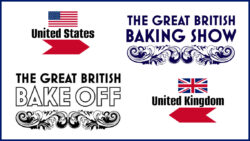
I am a big fan of the Great British Baking Show. I watch it like I watch sports—rooting for my favorites, exhorting them to make good moves and groaning when they make mistakes. In this new season, something extra was added: A sign language interpreter. One of the contestants, Tasha Stones, is deaf and the show has provided an interpreter to assist her in communicating with the judges, presenters, and her fellow contestants.
When not elbow deep in flour, Tasha signs as she speaks. While I am not fluent in American Sign Language (ASL), I have enough familiarity to realize that many of her signs are not what I expect. Then it struck me – Tasha and her interpreter are using British Sign Language (BSL). Of course! ASL is only used in the United States and Canada.
ASL and BSL – Alike, but Different.
Sign languages are comprehensive, natural languages that employ gestures, facial expressions, and body postures to convey meaning. These are the primary languages for many deaf and hard-of-hearing individuals worldwide, playing a crucial role in their daily communication, community identity, and cultural inheritance. Two prominent sign languages, American Sign Language (ASL) and British Sign Language (BSL), dominate the deaf communities in the United States and Britain, respectively. This blog post delves deep into a comparative analysis of ASL and BSL, focusing on their origins, alphabet systems, grammar, and dialects, highlighting both their unique characteristics and commonalities.
| For another blog article about communication differences between the United States and Britain, check out How Ted Lasso Highlights the Need for Localization. |
Origins
ASL traces its roots back to the United States, drawing significant influence from French Sign Language (LSF) and incorporating aspects of homegrown Native American sign languages. Conversely, BSL emerged in Britain, evolving from a mixture of LSF, Old British Sign Language (OBSL), and elements of Signed English[i]. The distinct origins of ASL and BSL are pivotal in understanding the reasons they have diverged significantly over time, becoming unique languages in their own right.
Alphabet System and Fingerspelling
In terms of the alphabet system, ASL features a one-handed setup for its 26 letters, each represented by a unique handshape. On the other hand, BSL operates with a two-handed manual alphabet primarily for words outside its standard lexicon. A critical comparison reveals that ASL signers tend to utilize fingerspelling more frequently, integrating it seamlessly into regular conversation. In contrast, BSL users predominantly reserve fingerspelling for specific scenarios, such as articulating proper nouns or unique names of places.

The show’s title has been localized for American audiences.
Grammar
The grammatical structures of ASL and BSL also present notable differences. ASL typically uses a topic-comment syntax, meaning the signer presents the topic first, followed by additional details or comments. For instance, in ASL, one would sign “CAR I HAVE” to indicate “I have a car.” Conversely, BSL tends to follow a subject-verb-object order, much like spoken English, hence, a direct translation of “I have a car” would maintain the same order in BSL. These structural variances significantly impact how thoughts are organized and conveyed, thus shaping the clarity and nuance of communication within each language.
Dialects
Just like their spoken counterparts, sign languages boast a variety of regional dialects, mirroring the rich culture and history of local deaf communities. ASL dialects include variants like Black American Sign Language (BASL), a unique form of ASL influenced by the cultural nuances of the Black Deaf community during the segregation era[ii]. In the realm of BSL, dialects such as Scottish Sign Language (SSE) exist, carrying imprints of the local Gaelic and Scots languages[iii]. These dialects are not just mere variations in signing; they’re a profound representation of the diverse cultural tapestry within the deaf communities.
Conclusion
While ASL and BSL share the common purpose of facilitating vibrant and clear communication within their respective deaf communities, they are distinctly different languages shaped by unique historical, cultural, and linguistic forces. Their differences in origin, alphabet system, grammar, and dialects underscore the richness of sign languages and the communities that use them. For hearing individuals, learning these sign languages not only paves the way for more inclusive communication but also offers a profound insight into the cultural richness of deaf communities. Embracing and understanding these languages can bridge the gap between hearing and non-hearing individuals, fostering a more inclusive world where everyone has a voice, or rather, a sign.
At Interpreters and Translators, Inc., we understand the intricacies of these beautiful languages and offer expert sign language interpreting services. Connect with us to learn more about how we can assist you in communicating effectively with the deaf and hard-of-hearing community. iTi is an NMSDC-certified minority-owned business.
| Talk to an Expert |
[i] American Sign Language vs British Sign Language: What Makes Them Different, (InterpretCloud, 2023)
[ii]Arizona Total Immersion Team, Choosing Between American Sign Language And British Sign Language, (Arizona Total Immersion, 2020)
[iii] What is American Sign Language, (National Institute on Deafness and Other Communication Disorders, 2021)







Comments are closed here.